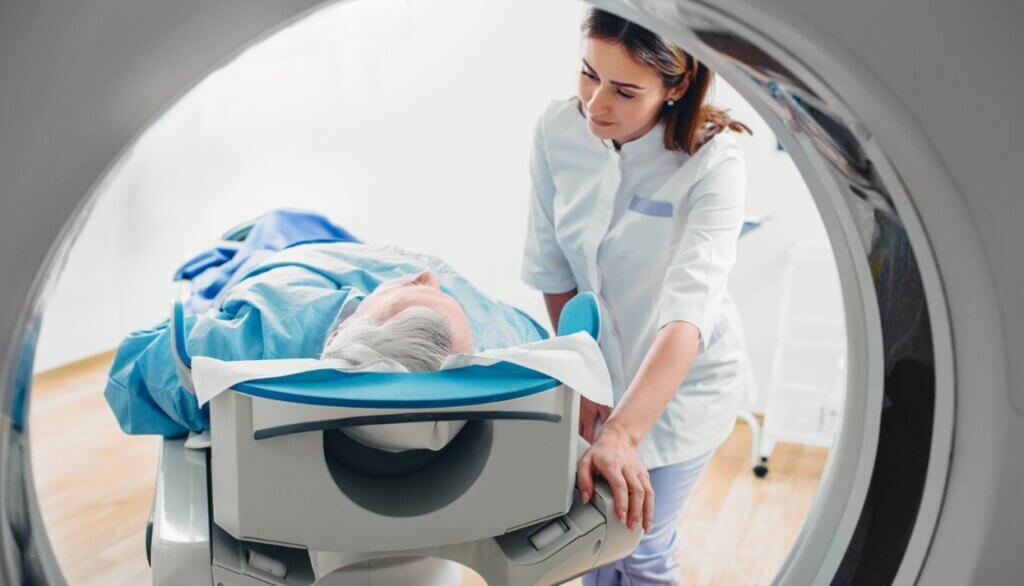
November marks Lung Cancer Awareness Month — a fitting time to spotlight one of the most important (and underused) tools we have for catching lung cancer early: low-dose CT screening.
There’s only one approved test proven to detect lung cancer at an early, more treatable stage. That test reduces mortality by 20%. And yet, nationwide, lung cancer screening remains strikingly underutilized.
The Power of Low-Dose CT
Low-dose CT scans (LDCT) are available at four ImageCare locations — Balltown, Clifton Park, Guilderland, and Latham — and they’ve been repeatedly shown to save lives by detecting lung cancer earlier.
Attempts to detect lung cancer early go back decades. Chest X-rays and sputum tests were once explored but ultimately proved ineffective. That changed in 2011 with the landmark National Lung Screening Trial, which showed that annual LDCT screening for high-risk patients lowered lung cancer mortality by 20%. The evidence reshaped national guidelines and ignited a nationwide push toward CT-based screening.
But progress has stalled.
Screening Rates Remain Low — And That’s a Problem
Despite clear evidence, only 16% of eligible adults get screened for lung cancer. That’s especially concerning because lung cancer remains the leading cause of cancer death among both men and women.
Although it’s the third most diagnosed cancer, lung cancer is often found late, when treatment options are limited. The contrast is stark:
- Stage I survival rate: more than 70%
- Stage IV survival rate: less than 10% at five years
The gap speaks for itself. Early detection saves lives.
Who Should Be Screened?
Confusion about eligibility and insurance coverage is one of the biggest barriers to screening. Here’s what you need to know.
According to the U.S. Preventive Services Task Force (USPSTF), annual LDCT screening is recommended for adults who:
- Are 50 to 80 years old
- Have a 20 pack-year smoking history (one pack/day for 20 years, two packs/day for 10, etc.)
- Currently smoke or quit within the past 15 years
These criteria apply to cigarette smokers and individuals who vape with nicotine, not cigar or other non-cigarette tobacco users. Patients must also have no symptoms of lung cancer (such as a new cough, chest pain, or unexplained weight loss) and be healthy enough — and willing — to undergo treatment if cancer is found.
Screening stops when a patient reaches 15 years since quitting (under current USPSTF/CMS criteria), develops a condition limiting life expectancy, or would no longer pursue curative treatment. It’s worth noting that the American Cancer Society updated its guidelines in 2023, removing the 15-year quit limit. But until USPSTF and CMS adopt that change, insurance coverage still requires it.
What the Scan Is Like
LDCT is quick, painless, and uses significantly less radiation than a standard CT scan.
- Scan time: about one minute
- Radiation dose: equivalent to 6 months of natural background exposure
- Coverage: from neck to pelvis
All LDCT studies are interpreted by ImageCare’s subspecialized cardiothoracic radiologists, with fast turnaround for both scheduling and results.
Because of its broad coverage, LDCT often reveals incidental findings, such as thyroid nodules, adrenal adenomas, or aortic dilation. When that happens, ImageCare’s Lung Cancer Screening Navigator coordinates follow-up imaging and communication with the referring provider.
Early Detection Saves Lives
If you think you might qualify for lung cancer screening — or you’re not sure — talk with your doctor. A simple conversation can determine whether a low-dose CT scan is right for you and could make all the difference. One scan at the right time can save a life. It might just save yours.
